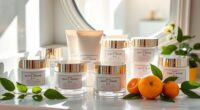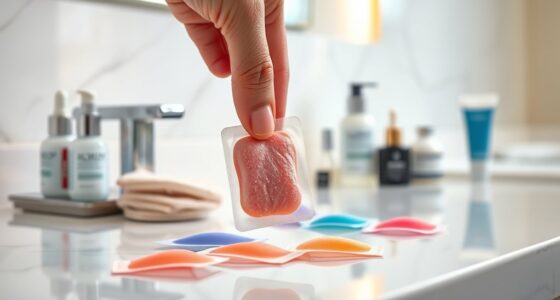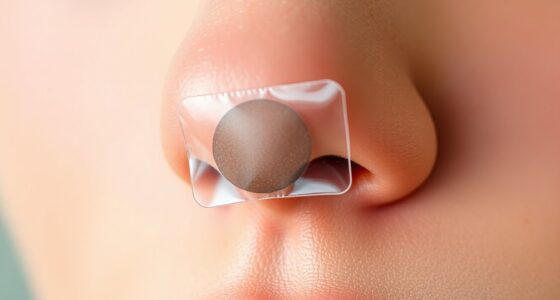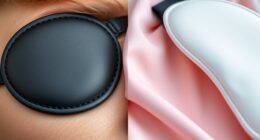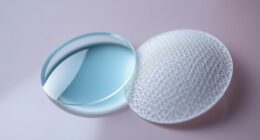Pimple patches can help with surface-level breakouts, but they struggle with cystic acne due to their limited penetration. Traditional hydrocolloid patches absorb oil and pus, but deep cysts often remain unaffected. However, microcrystal patches offer a deeper solution by penetrating further and infusing active ingredients like tea tree oil. For a thorough approach, consider combining treatments and preventative measures that target inflammation and oil production. Discover more effective strategies to manage cystic acne and enhance your skincare routine.
Key Takeaways
- Pimple patches are more effective for superficial pimples rather than deep cystic acne due to limited penetration depth.
- Hydrocolloid patches absorb surface oil but struggle to treat the inflammation of cystic acne effectively.
- Microcrystal patches penetrate deeper and may reduce inflammation in cystic acne by clearing clogged impurities.
- Consistent use of topical treatments like benzoyl peroxide and salicylic acid is crucial for managing cystic acne effectively.
- Combining pimple patches with a comprehensive skincare routine may yield better results than relying on patches alone.
Understanding Cystic Acne
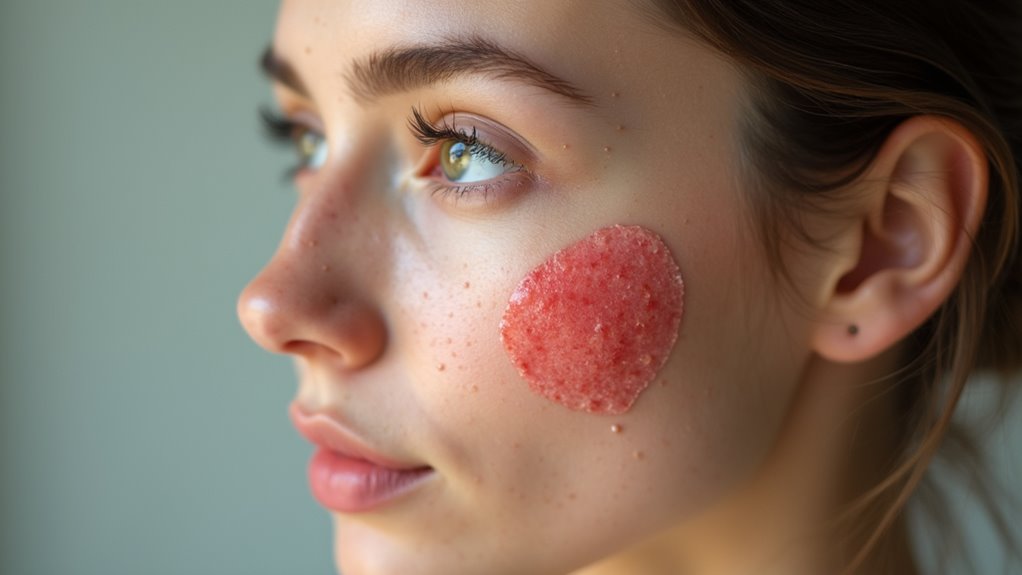
Cystic acne can be incredibly frustrating, especially when you don’t fully understand what’s happening beneath your skin. This severe form of acne manifests as large, painful, pus-filled cysts that develop deep within the skin, often causing significant redness and swelling.
The causes of cystic acne include hormonal fluctuations, genetics, and lifestyle factors that lead to increased oil production and clogged pores. It’s particularly common in oily skin types.
Because of its depth, cystic acne can result in permanent scarring, making effective treatment essential. While over-the-counter products may not cut it, prescription medications, topical creams, and advanced therapies like isotretinoin can help.
Acne patches may aid in reducing inflammation, providing some relief for those deep pimples.
What Causes Cystic Acne?
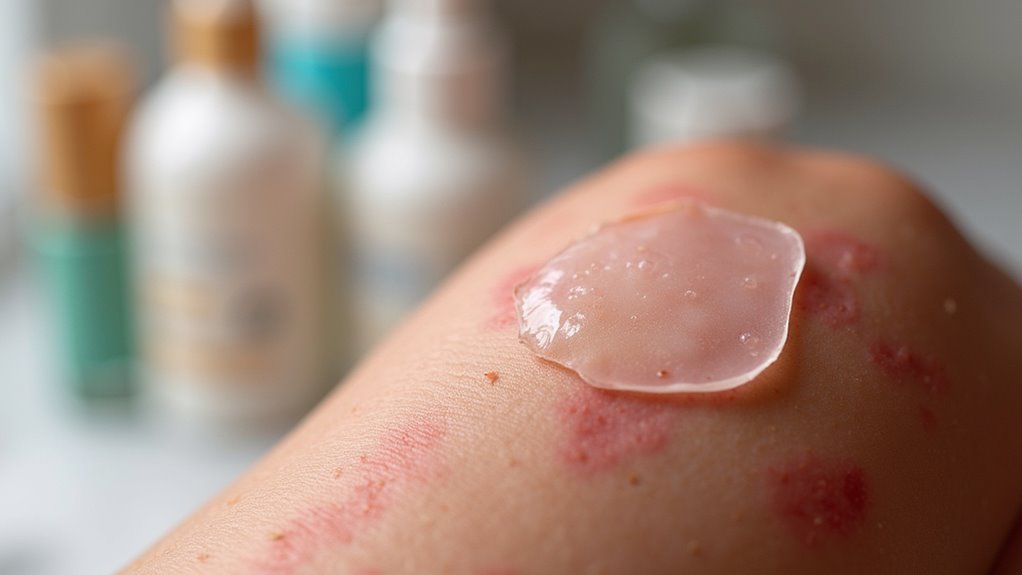
Cystic acne often arises from hormonal fluctuations that ramp up oil production, leading to clogged pores.
Genetics also plays a role, making some people more prone to breakouts.
Additionally, your lifestyle choices, like stress levels and diet, can greatly influence the severity of your acne.
Hormonal Fluctuations Impact
Hormonal fluctuations can greatly affect your skin, especially during menstrual cycles when sebum production spikes. Elevated androgen levels can stimulate sebaceous glands, leading to excess oil and clogged pores, which results in cystic acne. Stress can make things worse by increasing cortisol, further boosting oil production.
To manage these hormonal impacts, consider incorporating pimple patches with active ingredients designed to reduce inflammation into your skincare routine. Additionally, maintaining a nutrient-dense diet rich in foods like chia seeds can support overall skin health.
| Factor | Impact on Cystic Acne |
|---|---|
| Hormonal Fluctuations | Increases oil production |
| Elevated Androgens | Stimulates sebaceous glands |
| Stress | Triggers cortisol release |
| Diet | Influences hormonal balance |
| Exercise | Can help regulate hormones |
Understanding these connections can help you better tackle cystic acne.
Genetic Predisposition Factors
If you’ve got a family history of severe acne, you might be more susceptible to developing cystic acne yourself.
Genetic factors play a significant role in this condition, particularly affecting how your skin responds to hormones. For instance, you may have a heightened sensitivity to androgens, which increases oil production from your sebaceous glands.
This excess oil can clog your pores, leading to the formation of cystic acne. Additionally, genetic influences can disrupt skin cell turnover, making it more likely for dead skin cells to accumulate and block pores.
Understanding your genetic background is essential; it can help you develop targeted treatment and prevention strategies to manage cystic acne effectively.
Lifestyle and Diet Effects
While many factors contribute to cystic acne, your lifestyle and diet play an essential role in its development. High-stress levels can trigger hormonal fluctuations, increasing sebum production and worsening your cystic acne.
Additionally, consuming high-glycemic foods and dairy products can promote inflammation and oil production, exacerbating the issue. If you have a genetic predisposition to acne, these lifestyle factors can intensify your skin’s vulnerability.
An overgrowth of acne-causing bacteria, like Propionibacterium acnes, thrives in clogged pores, leading to more severe breakouts. To combat this, maintaining a consistent skincare routine with regular cleansing and using non-comedogenic products can help manage outbreaks and improve your skin’s overall health. Prioritizing your lifestyle choices for clearer skin is crucial, as emotional alignment can also influence your body’s vibrational energy and overall well-being.
Prioritize your lifestyle choices for clearer skin.
The Limitations of Pimple Patches on Cystic Acne
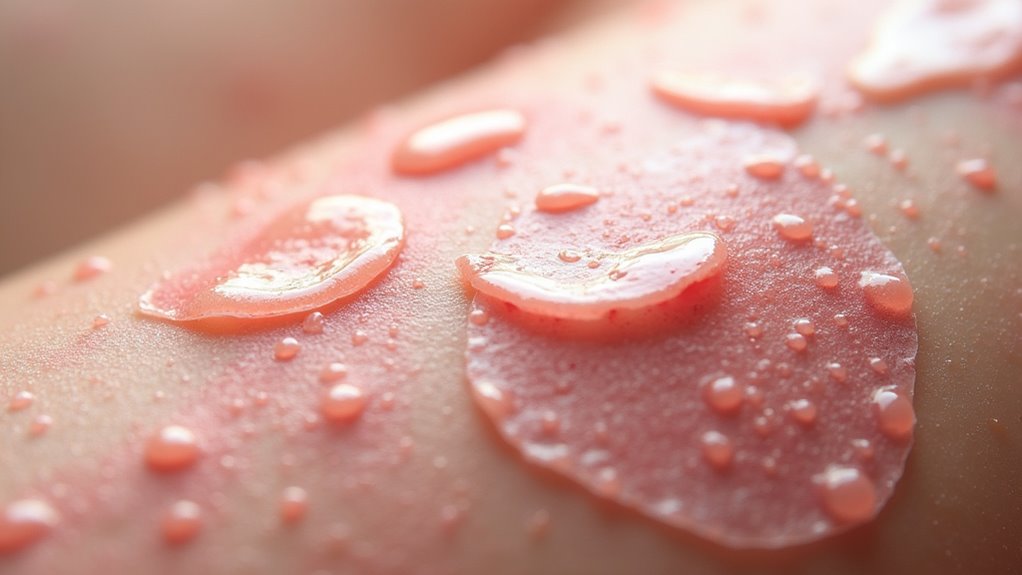
Although pimple patches can be a go-to for many acne sufferers, their effectiveness diminishes considerably when it comes to cystic acne.
These hydrocolloid patches excel at treating superficial pimples by absorbing excess oil and pus, but they struggle to reduce swelling and inflammation in deeper cysts.
While some patches contain active ingredients that may provide minor relief, they often can’t penetrate deep enough to address the underlying acne triggers, such as hormonal imbalances or bacteria trapped within the cysts.
Many users report mixed results, finding that while patches absorb surface fluid, they don’t lead to substantial improvement.
Relying solely on pimple patches without tackling these deeper issues may leave you feeling frustrated with your cystic acne treatment.
Microcrystal Pimple Patches: A Deeper Solution?

Could microcrystal pimple patches be the answer to your cystic acne struggles? These innovative patches utilize fine microcrystals infused with active ingredients, allowing them to penetrate deeper than standard patches. They often contain tea tree oil, known for its antibacterial properties, which helps reduce inflammation and clear clogged impurities.
| Feature | Microcrystal Patches | Traditional Hydrocolloid Patches |
|---|---|---|
| Penetration Depth | Deeper | Surface Level |
| Active Ingredients | Yes | Limited |
| Inflammation Reduction | Effective | Moderate |
Designed for both day and night use, microcrystal patches can accelerate healing and effectively target early-stage cystic acne, providing a deeper solution in your skincare routine.
Alternative Treatments for Cystic Acne
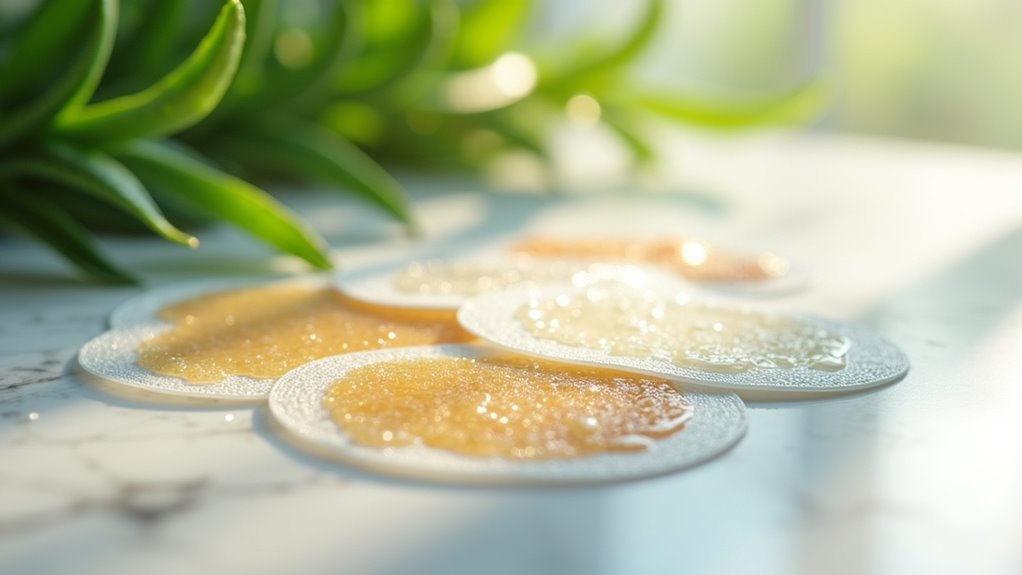
When it comes to tackling cystic acne, various alternative treatments can make a difference.
You might find topical options like azelaic acid and benzoyl peroxide effective for reducing inflammation, while natural remedies such as tea tree oil could also help promote clearer skin.
Exploring these options can empower you to find a solution that works best for your unique skin needs.
Topical Treatments Overview
If you’re struggling with cystic acne, exploring topical treatments can be a game-changer in your skincare routine.
These treatments often include powerful ingredients that target the root causes of breakouts. Here are some effective options to take into account:
- Benzoyl peroxide: Kills bacteria and reduces inflammation.
- Salicylic acid: Unclogs pores and prevents future breakouts.
- Hydrocolloid patches: Help absorb excess fluid and speed up healing.
- Retinoids: Promote cell turnover to keep pores clear.
Incorporating these topical treatments into your regimen may considerably improve your skin’s condition. Additionally, practicing proper toilet maintenance can prevent skin irritation from improper hygiene practices.
For severe cases, dermatologists may recommend combining them with oral medications.
Don’t forget, consistency is key in your battle against cystic acne!
Natural Remedies Effectiveness
While topical treatments are effective in managing cystic acne, many people seek natural remedies as alternative options.
For instance, tea tree oil is known for its antimicrobial and anti-inflammatory properties, making it effective for reducing inflammation when applied directly. Daily probiotics can also balance gut bacteria, potentially leading to clearer skin and fewer breakouts.
Ice cubes provide a quick way to reduce swelling and redness, offering temporary relief. Additionally, you can create an aspirin mask, leveraging salicylic acid’s ability to treat cystic acne and reduce pain.
Honey, with its antibacterial properties, can soothe and promote healing in lesions. Experimenting with these natural remedies might just help you find the relief you need. Furthermore, incorporating foods rich in antioxidants in summer squash may also support skin health and reduce inflammation.
Preventative Measures for Cystic Acne

To prevent cystic acne, it’s essential to adopt a holistic approach that combines skincare, diet, and lifestyle choices. Here are some effective preventative measures:
Adopting a holistic approach with skincare, diet, and lifestyle changes is key to preventing cystic acne.
- Cleanse regularly: Use a gentle cleanser with salicylic acid to remove excess oil, dirt, and bacteria that can clog pores.
- Eat balanced meals: Focus on a diet rich in antioxidants and low in refined sugars to reduce inflammation and hormonal fluctuations.
- Manage stress: Incorporate mindfulness and regular exercise to lower cortisol levels, which may trigger acne outbreaks.
- Avoid touching your face: Keep hair clean and off your skin to minimize the transfer of bacteria and oils that contribute to cystic acne development.
- Stay aware of hormonal factors: Understanding hormonal factors can help in identifying triggers that exacerbate cystic acne.
User Experiences: Do Pimple Patches Help?

Have you ever wondered if pimple patches really work for cystic acne? User experiences show that while these patches can help, their effectiveness often peaks with early-stage breakouts rather than deep, inflamed cysts. Many users find that pimple patches containing active ingredients like tea tree oil can minimize inflammation and promote healing. They also absorb excess fluid, providing relief from swelling. However, results can vary based on skin type. Additionally, patches made with hydrocolloid technology can enhance the healing process by drawing out impurities from the skin.
| User Feedback | Effectiveness | Recommended Ingredients |
|---|---|---|
| Reduces appearance | Limited for deep cysts | Tea tree oil |
| Helps with swelling | Best for surface-level | Microcrystals |
| Enhances skincare regimen | Varies by individual | Salicylic acid |
Integrating Pimple Patches Into Your Skincare Routine

Integrating pimple patches into your skincare routine can enhance your fight against cystic acne, especially when used correctly. Here are some tips for ideal use:
- Apply pimple patches on clean, dry skin for better adhesion.
- Leave them on for several hours or overnight until they turn opaque, indicating moisture absorption.
- Use patches as a spot treatment alongside products containing salicylic acid or benzoyl peroxide.
- Monitor your skin’s response to avoid irritation, especially if you have sensitive skin.
Frequently Asked Questions
Do Pimple Patches Work on Deep Cystic Acne?
Pimple patches generally don’t work well on deep cystic acne. They’re designed to target surface-level blemishes, so they can’t penetrate deep enough to address the underlying issues of cysts.
While some advanced patches might reduce inflammation, they won’t tackle the severe pain or inflammation associated with cystic acne.
For better results, you should consider consulting a dermatologist for oral medications or topical treatments that effectively target the root causes of your acne.
Would a Pimple Patch Work on a Cyst?
A pimple patch might help with a cyst, but its effectiveness can be limited.
These patches primarily target surface-level pimples, so they often don’t penetrate deep enough to treat larger, inflamed cysts.
However, they can absorb excess fluid and shield the area from irritants, which may reduce the chance of infection.
For better results, consider pairing patches with a solid skincare routine and consulting a dermatologist for more targeted treatments.
How Do You Shrink Deep Cystic Acne?
To shrink deep cystic acne, you should start by using targeted treatments like those containing benzoyl peroxide or salicylic acid, which unclog pores and reduce inflammation.
Applying ice wrapped in a cloth can help decrease swelling and redness.
Don’t forget to maintain a consistent skincare routine with non-comedogenic moisturizers to control oil production.
If over-the-counter options aren’t working, consult a dermatologist for stronger prescription treatments that can effectively tackle severe cases.
How Do Pimple Patches Draw Out Pus?
Imagine a sponge soaking up spilled water; that’s how pimple patches work to draw out pus.
When you apply one, its hydrocolloid material creates a moist environment that absorbs excess fluids and impurities. This barrier not only reduces inflammation but also helps flatten the blemish over time.
If the patch contains ingredients like tea tree oil or salicylic acid, it can target bacteria, enhancing the healing process as well.
Conclusion
So, can pimple patches really conquer cystic acne? Well, while they might not be the miracle workers you hoped for, they can still offer some relief. Think of them as your tiny, adhesive sidekicks—helping to reduce surface irritation and speed up healing. But don’t toss out your skincare arsenal just yet! Combining patches with other treatments and preventative measures could be your ultimate acne-fighting dream team. Embrace the journey to clearer skin; it’s worth every step!

